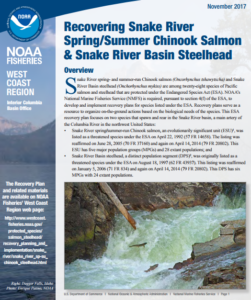Feds unveil key road map for salmon recovery
Posted /Uncategorized
NOAA recommends focusing on habitat and hatcheries; dam breaching possible future strategy
Lewiston Morning Tribune at lmtribune.com
December 13, 2017
-
By ERIC BARKER
The federal government released in-depth recovery plans for Snake River spring and summer chinook, fall chinook and steelhead Tuesday – the first such plans completed since the fish were placed under Endangered Species Act protections more than 20 years ago.
The documents are blueprints that lay out the types of actions needed to increase the abundance and productivity of the ocean-going fish to the point they are self-sustaining in the wild without the need of federal protection. It is likely to take decades, perhaps more, and cost hundreds of millions of dollars above and beyond what is already being spent, according to the documents.
“We definitely have a ways to go,” said Ken Troyer, Northern Snake River Branch chief for the National Oceanic and Atmospheric Administration at Boise. “I’m confident these recovery plans will get us there.”
Dam breaching is discussed as a possible future action that could help juvenile and adult salmon and steelhead survive their journey to and from the ocean, but it is not listed as a key strategy. Instead, the plans rely on things like continuing efforts to improve spawning and rearing habitat, reforming hatchery and harvest practices, reducing predators and taking actions to mitigate habitat degradation because of climate change.
The actions are largely voluntary.
“The recovery plan by its very nature is the best advice and guidance by my agency on all the sorts of things that need to be done to recover the species,” said Ritchie Graves, chief of hydropower division for NOAA Fisheries at Portland. “The (ESA) requires us to advise and lay out a road map. It doesn’t give us statutory authority to compel recovery.”
The plans say survival and abundance of the fish has increased as a result of several steps the region has already taken over the last two decades, including habitat work, the installation of weirs at the dams that allow juvenile fish to more easily find their way downstream and a host of other actions. But in the case of steelhead and spring and summer chinook, it says much more work is needed.
“The challenge is greater to recover spring and summer chinook and steelhead,” Troyer said. “They spawn farther up in the tributaries and they are vulnerable to habitat damage and climate change.
Fall chinook are closer to recovery. The government said it likely will follow a recovery strategy that doesn’t require the species to be re-established above the Hells Canyon Complex of dams.
Thanks largely to efforts by the Nez Perce Tribe to boost wild numbers with hatchery releases, fall chinook returns have increased from less than 100 at the time they were listed to returns of wild fish in recent years that have numbered more than 10,000.
“It demonstrates we are really on track to recover that species,” Troyer said.
However, federal fisheries officials say too many hatchery fall chinook are spawning with wild fish, and the places hatchery fish are released likely will have to be altered. Tom Cooney, a research biologist with the NOAA Fisheries’ Northwest Fisheries Science Center at Portland, said hatchery fish should be excluded from the Snake River upstream of its confluence of the Salmon River in Hells Canyon.
“The idea is to have hatchery fish come back to some place else other than upper Snake reach so we have really high percent of natural fish there.”
Though the plan will focus on recovery of fall chinook without reintroduction above Hells Canyon, an alternative that would require restoring fish above the Idaho Power dams is being retained.
While dams are identified as a key limiting factor for the fish, Graves said dam removal is not outlined as a concrete action because too much scientific uncertainty exists as to its effectiveness. About 50 percent of juvenile fish survive their journey through the eight-dam hydropower system now. But he said removing the dams may or may not boost survival to a significant degree.
He pointed to taking actions aimed at reducing the effects of climate changes as a better strategy. For example, he said adult spring and summer chinook that return to the Snake River basin must survive in tributary streams through the hottest part of summer before spawning. Their offspring also have to survive in the same streams. Habitat work like reconnecting streams to floodplains and increasing shade through the planting of riparian trees and shrubs can help mitigate higher water temperatures brought on by climate change.
Graves said if you increase survival at the dams through breaching or additional spill, it won’t pay dividends if spawning streams are overheated.
Others see it the opposite way. Michelle DeHart, director of the federal Fish Passage Center at Portland, said it’s clear that juvenile fish that pass the dams through turbines or bypass systems rather than going over spillways survive and return at lower rates. Sometimes they die at the dams, but studies conducted at the center indicate the fish often succumb later – known as delayed mortality – as a result of stress and injuries while passing the dams.
While habitat work is important and may lead to more juvenile fish leaving Idaho, she said they still face major challenges at the dams.
“It’s like a retirement portfolio. If you have one bad investment that is so negative it’s eating up all the profits from your other investments in your portfolio, you are not going to get anywhere.”
The recovery plans are broader in scope than biological opinions that look at federal actions – such as operating the hydropower system on the Snake and Columbia Rivers – to determine if they threaten the existence or habitat of protected species. Federal biological opinions on Snake and Columbia river dams have received intense scrutiny over the past two decades and have been the subject of successful lawsuits filed by the Nez Perce Tribe, state of Oregon and salmon advocates that forced the government back to the drawing board.
Last year, District Court Judge Michael Simon at Portland overturned the government’s latest biological opinion and required the agencies that operate the dams to conduct an exhaustive environmental impact statement outlining their effects on the fish. That separate process is scheduled to wrap up in 2021.
